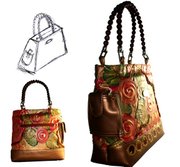By Teri M. Bethel
Anyone making a handbag is really looking for basically two things: functionality and the "wow" factor. One without the other is simply a dreary bag. And while you may be drawn to a bland look, a tantalizing handbag can be neutral without being boring.
Handbag construction is quite a simple task. Most things can be if you follow clear instructions. Okay, so the emphasis is on the clear, right? How many times have we sat down to a task, whipped out the instructions and felt as though they were written in a foreign language. Or perhaps the instructions just seemed to miss a few key points.
The key is finding the instructions (or the instructor) that speaks your language in clear simple terms--one step at a time. Lacking knowledge on any level can be confusing so it pays to invest in sound instruction.
In making a bag, chances are you already have a picture of the handbag in your mind. You've imagined it and now you want to create your masterpiece. Well just as a home-owner has the design of their home drawn up as a guide for the builder, it is helpful for the handbag designer to also have the bag that you see in your mind transferred to paper in an initial sketch. This is a preliminary guide for the person sewing the bag.
This sketch does not have to be professional; it's simply your guide. You may not stick with it but it is a great start; at least you have an idea of where you are going. Many times we change our designs when we are creating the pattern but that's quite alright; some of the changes are to ensure that the pattern works correctly. By the time you are through your handbag may look very different from your initial sketch but that's usually for the better.
In going through the design process, you will need to take into consideration what materials you will be using to create your bag. Many times having the fabric/materials is your first step and your bag is designed around it. But if it isn't, you will need to consider your bag's function and appearance; for example, if you want it for show or a toter, floppy or firm.
Your next step is to design your pattern. Doing this on a firm pattern paper is great if you wish to reuse your pattern. If you don't have the traditional pattern paper then chipboard or poster board can also be used.
Once you have your pattern and have selected and cut your fabrics, then stitching your pieces together is the next step to you having your incredible bag swinging from your arm.
Teri M. Bethel is a texture painting and handbag instructor. She is the designer of Teri Monique Handbags, a line of custom made art purses for ladies. Watch free video at: http://www.paintwithtexture.com





Comments
Use the comment form below to begin a discussion about this content.
Sign in to comment
Or login with:
OpenID